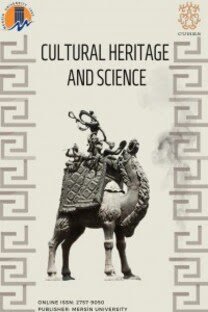Azulejos as an architectural element within the scope of design and conservation
Azulejos as an architectural element within the scope of design and conservation
___
- Miyata, E. (2017). Portuguese Intervention in the Manila Galleon Trade: The structure and networks of trade between Asia and America in the 16th and 17th centuries as revealed by Chinese Ceramics and Spanish archives. Archaeopress Publishing Ltd.
- Fantozzi, G. (2018). Welcome to Ceramics: A New Open Access Scientific Journal on Ceramics Science and Engineering. Ceramics, 1(1), 1-2. https://doi.org/10.3390/ceramics1010001
- Wunderlich, W. (Ed.). (2010). Ceramic materials. BoD–Books on Demand.
- Boch, P., & Ni, J. C. (Eds.). (2010). Ceramic materials: Processes, properties, and applications (Vol. 98). John Wiley & Sons. ISBN-13: 978-1-905209-23-1
- Rawson, P. (2011). Ceramics. University of Pennsylvania Press, 1-4. Inc. https://www.perlego.com/book/732112/ceramics-pdf
- Karataş, L. Conservation status of intangible cultural heritage after restoration: Case study of Mardin Spice Bazaar. Cultural Heritage and Science, 3(2), 30-36.
- Geraldes, C. F. M. (2021). Conservação dos azulejos modernos Portugueses (1950-1974).
- Helvacıkara, F. T. (2023). Portekiz’de Toplum Kültür İlişkisi İçinde Mimaride Azulejo Kullanımı. Journal of Social, Humanities and Administrative Sciences, 9(61), 2320-2336.
- de Carvalho, R. S. (2020). The iconographic role of azulejo frames. Word & Image, 36(2), 135-165.
- Mimoso, J. M., Pais, A., Filipe, V., Esteves, M. D. L., Pereira, S., Matos, M. A. P. D., ... & Candeias, A. (2019). Analytical study of the 16th century azulejo panel called “de Nossa Senhora da Vida” and related archaeologic findings. Studies in Heritage Glazed Ceramics: On the origin of majolica azulejos production in Portugal 1 (February 2019), 77-92.
- Pereira, M., de Lacerda-Aroso, T., Gomes, M. J. M., Mata, A., Alves, L. C., & Colomban, P. (2009). Ancient Portuguese ceramic wall tiles (“Azulejos”): Characterization of the glaze and ceramic pigments. In Journal of Nano Research (Vol. 8, pp. 79-88). Trans Tech Publications Ltd.
- Damas, A. L., do Rosário Veiga, M., Faria, P., & Silva, A. S. (2018). Characterisation of old azulejos setting mortars: a contribution to the conservation of this type of coatings. Construction and Building Materials, 171, 128-139.
- Mimoso, J. M., Pais, A. N., Morna, T., Simões, J. M., Esteves, M. L., Cardoso, A. M., ... & Candeias, A. (2019). A research on the azulejo panels of the São Roque chapel in Lisbon. Studies in Heritage Glazed Ceramics, (1), 93-112.
- Mimoso, J. M., Pereira, S., Pais, A. N., Antunes, M. A., Cardoso, A. M., de Lurdes Esteves, M., & Candeias, A. (2019). A technical comparison of three renaissance azulejo panels from the workshops of Lisbon. Studies in Heritage Glazed Ceramics No, 1.
- Mimoso, J., Pereira, S., Pais, A., Antunes, M. A., Cardoso, M., & Esteves, M. (2019). A comparison of the earliest faience tiles produced in Lisbon with earlier and later types. Studies in Heritage Glazed Cera mics on the origin of majolica azulejos production in Portugal, 25-47.
- Leitão, H., & Gessner, S. (2014). Euclid in tiles: the mathematical azulejos of the Jesuit college in Coimbra. Mathematische Semesterberichte, 61, 1-5. https://doi.org/10.1007/s00591-014-0130-8
- Pais, A. (2019). Study of the azulejo panels in Graça Church signed by João de Góis in Studies in Heritage Glazed Ceramics, No. 1. LNEC, Lisbon, 47-66.
- Carvalho, R. S. (2019). To be part of... architecture, decoration or iconography. Documenting azulejo as integrated heritage. ISPRS Annals of the Photogrammetry, Remote Sensing and Spatial Information Sciences, 4, 39-46.
- Calado, R. S. (1989). The Azulejo museum: a unique glazed tile collection in Lisbon. Museum International, 41(1), 10-12.
- Yılmaz, L. The digital memory for the cultural heritage in the 21st century. Cultural Heritage and Science, 3(1), 1-5.
- Antunes, J. L. F., & Tavares, D. S. (2003). The removal and replacing of architectural glazed tiles-azulejos. In El estudio y la conservación de la cerámica decorada en arquitectura: un compendio de colaboraciones, Roma, Enero 2001-Junio 2002 (pp. 22-27).
- ICOMOS (2023). Nota Alejandro Artucio: Museo de Azulejos Franceses, Museo Lussich, Intendencia de Maldonado. https://www.icomos.org.uy/
- Santos, C. G., Araújo, T. D., Junior, P. R. C., & Meiguins, B. S. (2017). Recognizing and explorıng Azulejos on hıstoric buildings’ facades by combining computer vision and geolocation in mobile augmented reality applications. Journal of Mobile Multimedia, 57-74.
- Almendra, R., & Ferreira, J. (Eds.). (2020). Research & Education in Design: People & Processes & Products & Philosophy: Proceedings of the 1st International Conference on Research and Education in Design (REDES 2019), November 14-15, 2019, Lisbon, Portugal. CRC Press.
- Cruz, P. J. (Ed.). (2019). Structures and Architecture: Bridging the Gap and Crossing Borders. CRC Press.
- Tekocak, M. (2021). Anemurium Antik Kenti’nde Kültürel Mirası Koruma ve Yaşatma Çalışmaları. Kültürel Miras Araştırmaları, 2(1), 1-15.
- Çorakbaş, F. K., & Bektöre, E. M. A GIS-based method for researching the historical and architectural heritage of the mountainscapes: The case of Uludağ/Olympus Monasteries. Cultural Heritage and Science, 3(2), 73-85.
- Acıelma, B., & Güngör, Ş. (2021). Kültürel mirasın korunması ve turizm ilişkisi bağlamında Altınköy Açık Hava Müzesi. Kültürel Miras Araştırmaları, 2(2), 72-77.
- Yayın Aralığı: Yılda 2 Sayı
- Başlangıç: 2020
- Yayıncı: Mersin Üniversitesi
Azulejos as an architectural element within the scope of design and conservation
Lale KARATAŞ, Murat DAL, Aydın ALPTEKİN, Murat YAKAR
3D modeling of Narlıgöl Natural Heritage with unmanned aerial vehicle data
Hacı Murat YILMAZ, Nusret AKTAN, Adem ÇOLAK, Aydan YAMAN
A web scrapping and AI approach for archeologists to analyze the ancient cities
Nusret DEMİR, Cem Sönmez BOYOĞLU, Deniz KAYIKCI
Example of 19th century industrial heritage: Ayvalık Tariş olive oil factory
